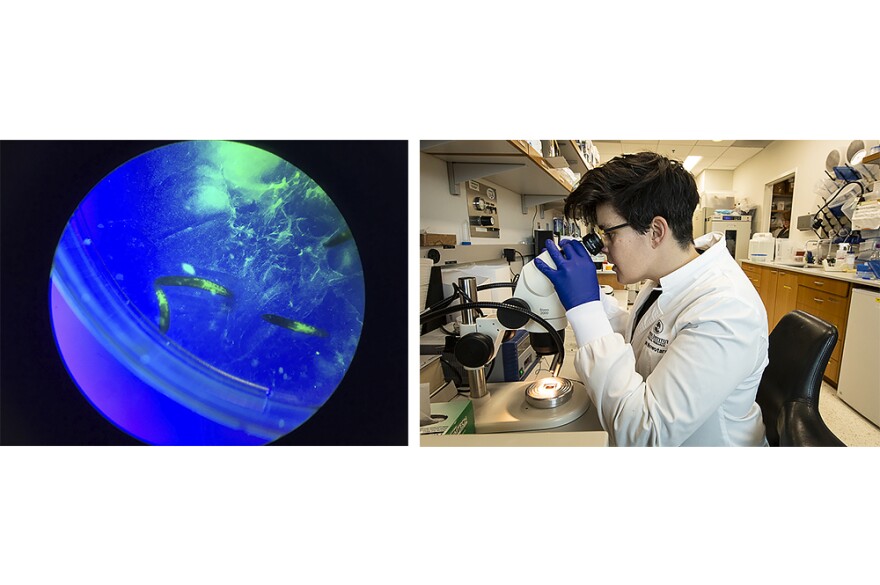What if you accidentally cut off a piece of your finger, and two weeks later that piece grew into your clone? Tiny creatures with that ability are swimming in tanks at Kansas City's Stowers Institute for Medical Research, and they've inspired a new collaboration between scientists and artists.
Planarians, or flatworms, can be cut into as many as 18 fragments, and each piece will regenerate into a complete animal.
"I didn't even know what a flatworm was, had no clue," says Jason Pollen, a fiber artist who retired from the Kansas City Art Institute a decade ago. "So it's just another universe of creatures that exist side-by-side with us that have very different kinds of life cycles, that clone themselves."
Pollen knew scientists who worked at Stowers and wanted to find a way to collaborate. So, over the summer, a small group of researchers and artists made trips to the lake in Swope Park to hunt for planarians, which are commonly found in waterways around the world.

Their weekly outings eventually gave shape to a new art exhibit that includes Pollen's fiber pieces, video installations and drawings by scientists who also happen to be artists.
Scientists at Stowers, where Steph Nowotarski and Mol Mir work, have been studying flatworms for decades. Hundreds of thousands of the tiny animals live in their holding tanks.
"Yeah, we're in the planarian ranch, which is in the lab, and it's where we are keeping the planarians that we are working with, mostly in ziploc containers," says Nowotarski. "It's really high tech."
The flatworms are long and thin, with a shovel-shaped head and two eyes. They seek the safety of darkness, hiding under rocks and leaves — in the wild, planarians are often dark brown. But when you feed them colored food, they turn a rainbow of colors. The team has been feeding them pigment and then filming them as they glide around in petri dishes.
"It's like the planarians themselves are our art," Nowotarski says. "So we played around with feeding them different pigments. And so this is watercolor pigment. Literally you can buy it at Dick Blick. So this is literally planarians holding watercolor. So they are like little mini brushes, if you will."

Mir went to work in the lab after graduating from the Art Institute.
“At work when I’m doing drawings, it’s strictly thinking about how will this best communicate to someone who is looking at it," Mir says of the images they create with electron microscopes.
In the studio, though, Mir uses watercolors to make images based on magnified slices of worms. Blobs of blue and lavender form many of the structures that cover the paper.
"Here," Mir says, "this is more about creating a composition and visual interest, playing with color and form and it’s more play."

"It just blows my mind all the time just how complicated the world inside these animals is," continues Mir. "They're so tiny and they're so cute with their googly eyes. But you look inside such a small portion of the animal just a single slice and there are so many things to see."
In the video installation, viewers will get to see much larger versions of flatworms swimming around the gallery walls. William Plummer, another Art Institute graduate, experimented with projecting the images. In Plummer's projections, some of the planarians — each as large as an eyelash in real life — are as big as humans.
"It's so different how your understanding changes when you can see them large and you see their little photoreceptors that kind of look like cute little eyes," says Plummer. "You understand their movement in a different way."

Plummer, who also plays the cello, recorded music to accompany that motion. With Brad Highnam on upright bass, Dylan Cramm on horn and bass guitar, and an artist who goes by the name of 2007 Balquier, Plummer created an atmospheric soundtrack that imagines the flatworm's universe.
According to Pollen, this show is all about changing perceptions about the world around us.
"I think we all learn from one another," Pollen says, "and just revel in this playful project with planarians at the centerpiece."

Plummer says studying flatworms has enriched the art, and they hope it may enrich the science too.
"This collaboration really shows that artists and scientists can work together to create something really new," Plummer says.
If nothing else, the show will help more people understand the beauty of flatworms.
"Body of Inquiry: The Art, Biology, and Being of Flatworms" opens with a reception from 5-8 p.m. on Thursday, Jan. 30, at the UMKC Gallery of Art, 203 Fine Arts Building, University of Missouri-Kansas City, 5015 Holmes Street, Kansas City, Mo., and continues through March 7.
Julie Denesha is a freelance photographer and reporter for KCUR. Follow her on Twitter @juliedenesha.




